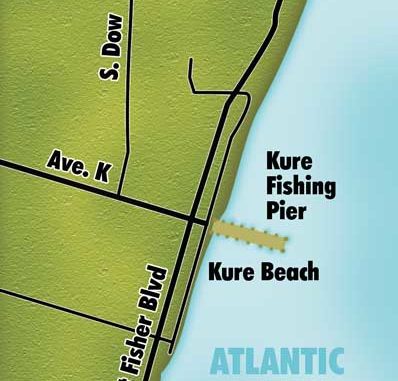
Mackerel experts are pier-fishing’s blue bloods at Kure Beach.
An elite crowd gathers at the end of every oceanfront fishing pier. From spring to fall, these dedicated anglers stand in the shadows of long rods that sway to the rhythm of the waves tugging at their lines.
Although far removed physically — and even farther evolved in fishing techniques — from anglers casting along the sides of the pier, most of the end-of-the pier gang started out just like them, as simple bottom fishermen.
Kure Beach Fishing Pier is one 18 piers remaining along the North Carolina coast. Its weathered planks have welcomed fishermen young and old and weathered many hurricanes. Mike Robertson’s family has owned the pier since 1923.
“The biggest king mackerel caught from the pier weighed around 50 pounds,” Robertson said. “The same fishermen caught a 56-pound cobia the same day.”
Robertson said king mackerel are an exciting fish to catch, especially from a pier. But the excitement of landing a large fish shouldn’t overrule common sense.
“If a rod peels out and the angler is not there to attend to it, other anglers should handle it,” he said. “I’ve seen three king rigs there with two anglers somewhere else. What’s going to happen if two fish strike? That’s why we have a rule that allows only one king mackerel set-up per angler. If you go elsewhere, remove your bait from the water.”
Robertson said when a new fishermen arrives, he should select a spot that keep his baitfish from tangling with another angler’s baitfish.
“You might have to fish closer or drop your anchor line in where it won’t tangle another line,” he said. “It takes a community of anglers working as a team to be successful.
“Most anglers bring their baitfish in or move it out of the way as another angler is fighting a fish. Sometimes you gaff a fish on the fly, and sometimes he comes in turned on his side so he can be led to the gaff. Success comes through experience and listening to the guys who’ve done it before.
“Talking about what you’re going to do when a fish strikes is most of the fun, because you’re going to wait a long time between strikes. Everyone gets to know everyone else, which creates the trust that results in landing big kings.”
Although there is no official pier record, Kure Pier has seen its share of big kings. Many anglers have vied for the title of “Pier King of King Mackerel Fishermen.” One of the current cream-of-the-crop talents started out like the other sun-leathered old timers. Tim Barrier lives in Salisbury, but he visits the pier every other week to fish for king mackerel.
“I’m only 30, but I’ve fished for kings for 20 years,” Barrier said. “Kure is my home pier, but I fish at others. The first time I walked out on Carolina Beach Fishing Pier, there were 20 king fishermen. They only watched as while I unloaded my cart, but when I set my rods, they shook my hand and welcomed me. Obviously I knew what I was doing. so they figured I was a good king fisherman.”
Barrier is a technician for Viking kitchen appliances. Talented with gizmos and gear, it’s small wonder he manufactures a line gear for fishermen who target kings on piers. He said the hard part of getting started is getting everything together.
“I make everything by hand and sell it to other king mackerel fishermen through my website,” he said. “I make own leaders, anchors, rod holders, gaffs. The guy who taught me how to king-fish (and) showed me how to make everything died shortly afterward. Everybody kept asking me about my equipment, so, now my pier fishing supplies are sold to anglers from California to New Jersey.”
Barrier started pier fishing at age five. His mother had grown up in Kure Beach, and his parents returned their for vacations.
“The first time my dad took me, I was hooked,” Barrier said. “When I was 10, I saw these guys with big reels at the end of the pier. I saw a king caught, and David Blainey, a pier regular, started showing me how to fish for kings. It wasn’t until I was 15 that I caught my first king, using David’s rig.”
Barrier became a pier regular as soon as he turned 16 and could drive, then he began assembling his own style of equipment. Some anglers use stretch cords or strap PVC tubes to rails to hold their rods, but Barrier he uses rod holders with aluminum bases that slide onto the horizontal rail. A rod holder holds the anchor rod upright, while another rod holder allows the fighting rod to be set in a position that’s close to horizontal.
“I use a Penn International 30 VSW reel with 850 yards of 40-pound fluorocarbon line on a Key Largo 6½-foot handmade rod with a medium-heavy action,” he said. “When I go out on a boat, I use the same rod. I can land anything with it, including a tarpon.”
Barrier’s anchor rod is a conventional surf rod and Ambassadeur 7000 reel spooled with 240 yards of 17-pound Berkley Big Game mono. He casts about half the line off the reel when using one of his 5-ounce anchor weights with five 3/32nd-inch diameter prongs. Once the line is set, he slides his trolley rig down the line with a baitfish.
“I tie a 6½-foot rig with a single piece of a 7-strand uncoated wire leader,” he said. “At the end, I tie three 4/0 treble hooks with Figure-8 knots about one foot apart. At the other end, I tie a 300-pound swivel and tie the swivel to my line.”
For what he calls his “pop-off” rig, Barrier ties a snap swivel to a leader, threads on a 2- to 4-ounce egg weight, then ties a clothespin to the other end. The clothespin snaps onto a rubber band tied to the 300-pound leader swivel. When a king strikes, the clothespin frees or breaks the rubber band.
Bluefish and spot are Barrier’s favorite baitfish, but croaker, pinfish and other small bottomfish will do in a pinch. Berrier hooks them behind the head with one treble and hooks a second treble behind the dorsal fin, leaving the third hook dangling.
“I use a 7-strand wire because it’s more flexible than single-strand wire,” he said. “It allows the baitfish more natural movement.”
Berrier catches his own baitfish with a spinning rod, or he nets a fish out of a bait tank that fishermen keep supplied. Sometimes, Robertson fills it menhaden caught with a cast net.
“I use 22 pounds of drag and set it with a scale,” Barrier said. “Most king fishermen use three to five pounds, which lets a big bluefish or shark take all the line. I might lighten up the drag to let a king run. I take the clicker off, see how hard he’s pulling, and back off to 14 or 15 pounds of drag. I may adjust the drag several times during the fight.”
Barrier said a king makes one long run, followed by a short spurt. A really big king may make several short surges.
“By the time a king is at the pilings, he’s usually on top,” he said. “If he runs back toward the pilings, I lock the drag so I can horse him out of the pilings. If you’re using 20-pound test, and it’s a big king, the line will break. That’s when 40-pound fluorocarbon makes a difference. The average guy uses a 4-or 5-foot leader with 20-pound mono. If the line hits the piling, it will break. Fluorocarbon is more abrasion-resistant.”
Barrier lands 90 percent of the kings he hooks. Fish he doesn’t land are often lost because of other angler’s mistakes.
“Other fishermen not clearing their lines is the main reason I lose kings,” he said. “When a king is running, the best thing is to do whatever the guy fighting the fish says. If the fish goes over your anchor line, drop your anchor line. If he’s going toward your pop-off rig, pick it up. You need to attend to your own rod. If there are a dozen rods and only three guys watching them, it’s a recipe for lost fish. Some people don’t want you to touch their rod, but if you leave your rod, you should designate someone else to tend it.”
Gaffing is another big reason for hooked kings being lost. Kings are gaffed with a weighted gaff lowered by a rope.
“I make a pier gaff from 1½-inch solid stainless steel rod,” he said. “It has a 7-3/8-inch diameter hook and weighs 9½ pounds. With a heavy gaff, I don’t have to worry about the wind blowing it away from the fish.”
When a king is exhausted and gaffs are lowered, the angler fighting the fish decides which person should gaff it. Anglers with the most experience are usually the best at gaffing.
“There’s nothing like the thrill of that king coming over the rail,” Barrier said. “It’s what keeps me coming back, again and again.”
Barrier knows anglers who have fished for kings for 40 years. He said newcomers should pay attention to them and learn. When he arrives at a pier, about 70 percent of the king fishermen recognize him, but newcomers are welcomed.
“An 82-year-old gentleman who saw me catch a king last year came up to me later,” he said. “He said he heard I was the guy to talk to about catching kings. He had never caught a king, so I’m going to help him. A newcomer can catch a king as easily as an veteran if he asks questions.”
In 2007, Doug Shores of Randleman saw hot king-fishing action on a pier and decided to give it a try. He fished alongside Barrier and liked king fishing so much he designed his own rod holder, which he had a relative construct of aluminum.
“I usually fish with sand fleas from the beach,” Shores said. “I went out on the pier to fish for kings and caught five in four days. I had fished for kings 10 times over three years, and all I had caught were sharks. It’s luck of the draw, but if you go out there and study what the experts are doing at the end of the pier, your chance of success will go up.”

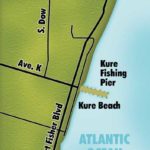
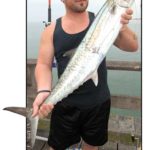
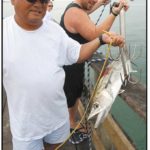
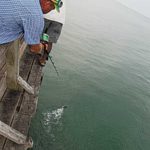
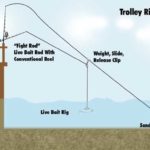
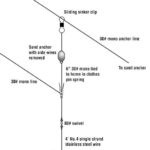
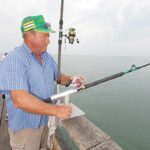
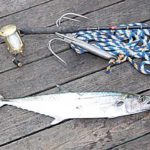



Be the first to comment